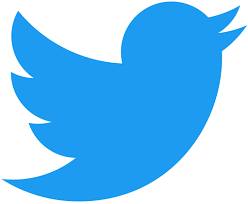The division of roles in knowledge management tools
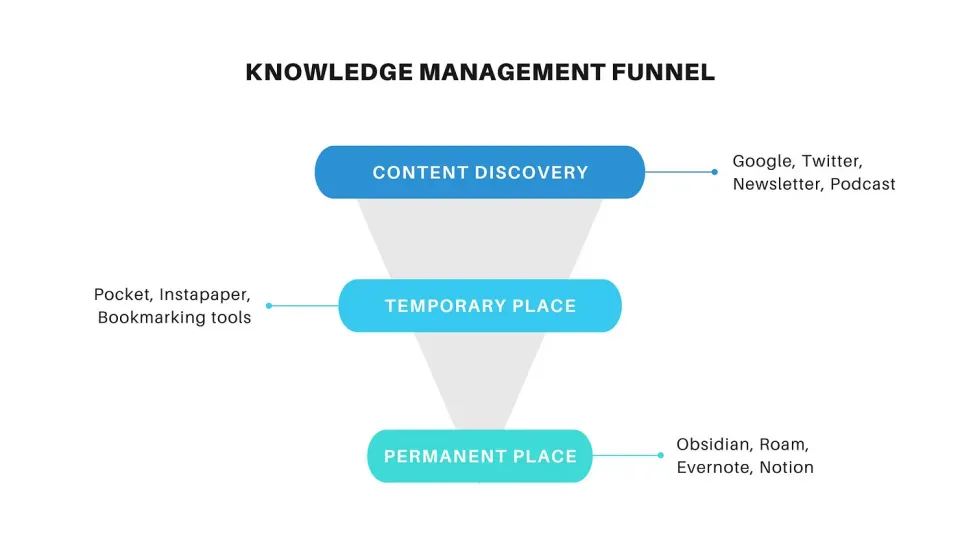
As we build products that manage knowledge and content, we come across many questions. One of the most interesting questions is why do people keep the content they discover and what they learn? I think content that you happened to find a few years ago is not likely to be valuable today, and it is not likely to be useful unless you have done a lot of research in the field and found it or learned about it. Nevertheless, I think the behavior of people trying to leave content behind is interesting, and the following are some possible reasons why.
- By looking back at information, we can remember it.
- We can see the context and relevance and learn from it by organizing certain content and information.
- When we come across good content, we want to keep it and be able to refer back to it at any time.
- We want to be able to refer to and analyze our current thoughts and feelings in the future.
- We fear that it will be wasted as we’re investing time and effort.
The third is in the context of curation, where quality content is of value in a world of so much information. It is an intrinsic human need to select and preserve quality content. Robin Good, an expert in curation media technology, states in his article, “Why To Curate Information”
“Content curation is a natural solution to a natural phenomenon: resource abundance. […] It is a natural, spontaneous phenomenon.”
The fourth was a concept that I was taught while interviewing someone, and she stated the following in her blog.
“During my studies, I’d learned a few interesting things, that I’ve never ever really talked to someone about, and never tried to write them down — and now I wish I had those insights written down, so that I could analyze them a bit more — perhaps I could find more sense in my present that I can’t seem to find.”
And in response, she recommends the following:
“I highly recommend to scribble down any spontaneous idea or thought — in an app editor, google docs file (you find your own suitable way) — but please do, you would never know how this idea could help you in the future, or even might help to spark an even better idea.”
I think the point of writing it down is very important, and in this regard, I think there is a fundamental need for confirmation of personal identity. A person’s identity is something that can be surprisingly confusing, and people confirm their identity either in their relationships with others or in an explicit history that is consistent with their past self. I think that logs that exist over time, and data that relate the past self to the present self, are very important in terms of knowing and reaffirming oneself.
The fifth is psychological safety. I believe that psychological safety is one of the most important reasons for preserving knowledge and content.
Matthew Guay, creator of a writing tool called reproof, states in his article “Notes apps are where ideas go to die. And that’s good.”
The problem is we ascribe value to our thoughts and findings. They took time to think up and find; they’ve got to be worth something. We’re scared to lose them. As Daniel Kahneman explains the concept of “Loss aversion” in Thinking, Fast and Slow, “The response to losses is stronger than the response to gains.”
Thus, people have a strong emotional motivation to avoid losses. I believe that this motivation, along with practical utility, is what drives the development of knowledge management tools.
So, should we be able to store any good information or knowledge we encounter? Should we create an all-in-one place for this purpose?
I don’t think so. It requires thinking about the flow of how people discover, consumes, and store content, and the jobs they do at each stage.
Generally speaking, people follow the following flow from the time they collect information to the time they store it.
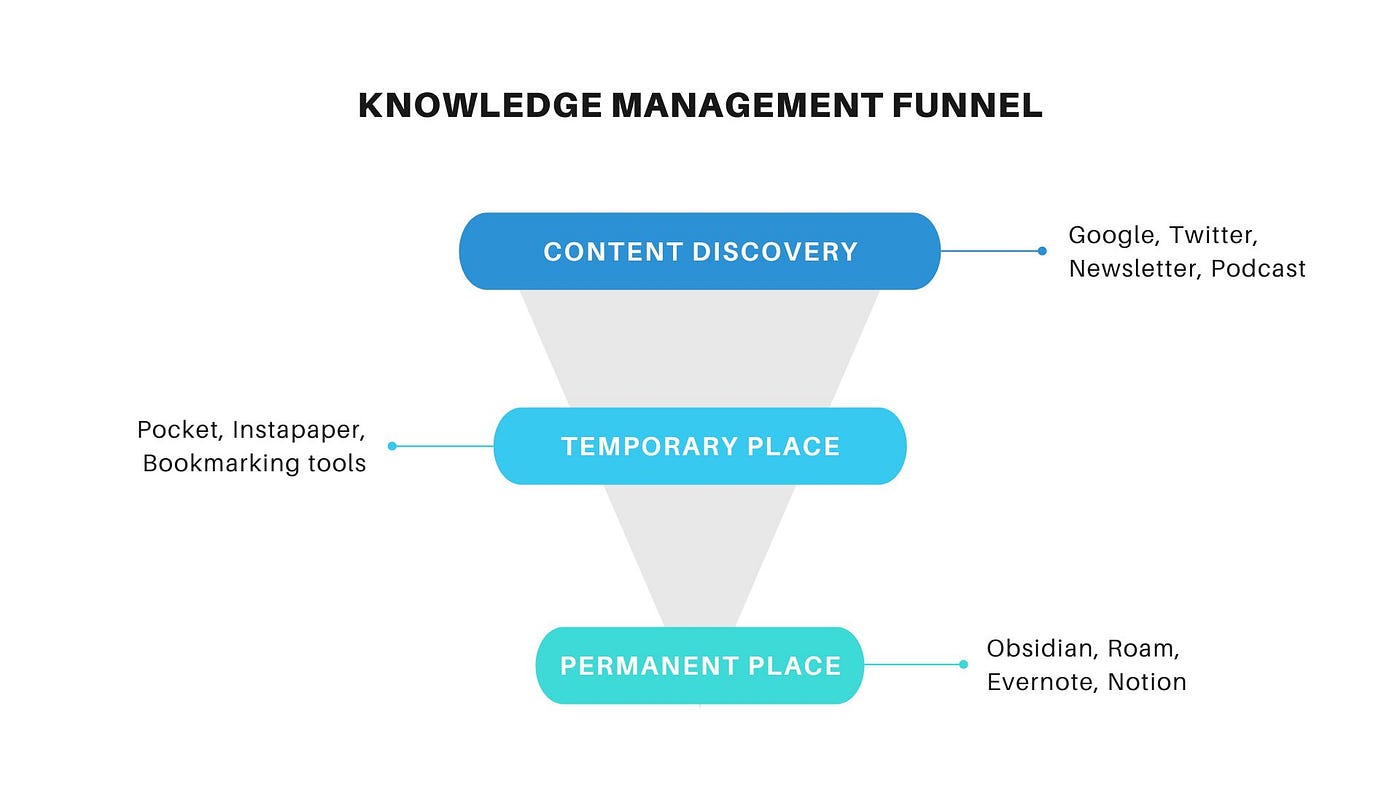
- Content Discovery
- The temporary storage of content that looks good or important
- Permanent storage of really good content or essence/knowledge
In between the second and third are the actions of actual consumption, such as reading the actual content or organizing important points.
And the corresponding services, platforms, and means may include:
- Content discovery: Search engine, newsletter, YouTube, Podcast, Pinterest, Twitter, Linkedin, etc
- Temporary place: Pocket, Instapaper, Send to Kindle, Feedly, built-in browser bookmark, etc
- Permanent place: Roam Research, Obsidian, Notion, Evernote, etc.
And the jobs at each stage are considered as follows
- Content discovery: Discover good content and information of interest.
- Temporary place: Temporary storage of interesting content. Forget what you need to remember (recover working memory). Close a large number of open tabs to streamline your work. Filter content that you want to read, or delete if you don’t want to read it.
*Another effect is to make people read longer content.
- Permanent place: High-quality content, essence, and knowledge are stored stably and can be referred to at any time. Extract or organize and store even better content and information from the content and information in a Temporary place.
The assumption of using separate products for Temporary and Permanent places makes sense given the use cases and jobs for each, but more detailed reasons are given below.
- Once you have gone through your filter, the content list (Temporary place) has accumulated more useful things for you than the Discovery place. However, there is still a lot of noise in the actual content because not all of the content has been filtered through.
- Permanent places must be able to aggregate and quickly find really good high-quality information; too much noise does not do that efficiently.
- People expect one job for one product/function. A job is tied to the feelings and mindset of the person using the product, and it makes more sense to switch products when doing a different job.
Of course, for some people, Temporary Place, and Permanent Place may match and can be managed properly, but this is likely due to a high level of filtering when temporarily storing content or the ability to declutter stored content.
It is also not completely impossible to have both Temporary and Permanent places within the same knowledge management tool by switching accounts or changing the UI.
Given the jobs and roles of Temporary and Permanent places, it makes sense to take each of the following basic product strategies.
Temporary place:
- Increase the types of media that can be handled.
Web articles, images, PDFs, videos, audio, book, etc. - Increase the number of media storage sources that can be supported.
Twitter, Pinterest, upload from a device, YouTube, Bookmark import, Kindle, Medium, Linkedin, etc. - To save temporarily and easily, make it available seamlessly from anywhere. What you save on your mobile can be read on your desktop/tablet.
- To be able to quickly find temporarily saved items. Make it visible in list and chronological order.
- Since it serves as a middle ground, it should be able to import and export content.
- Do not seek to serve as a Permanent place, but work with the Permanent place to facilitate archiving and deleting of consumed content in the Temporary place (to avoid increasing noise and becoming a link graveyard). Or make it less of a concern.
Permanent place:
- Ensure high stability and reliability. Store content in local files and the cloud.
- Ensure easy and efficient search and reference.
- Only really good content and knowledge should be stored. In other words, avoid noise as much as possible.
- Provide a mechanism to delete and organize content regularly.
Further value-added strategies include
- Visualize (Graph view, tag counter)
- Backlinking (Word units, Roam, etc.)
- Make pages or parts of content publicly accessible (Notion, Obsidian)
When you think about it this way, you realize that there are separate jobs for each layer of knowledge management, and the tools used have different roles. Knowledge management systems that advocate an all-in-one place appear year after year, but, understandably, they do not last long.
I also include deletion, organizing, and archiving strategies in both Temporary and Permanent places. This is because, in both, excessive accumulation of content and knowledge can ultimately cause users to leave. The utility gained from the accumulation of content, information, and knowledge is outweighed by the effort of organizing them and the inconvenience of not being able to refer to what you need when you need it.
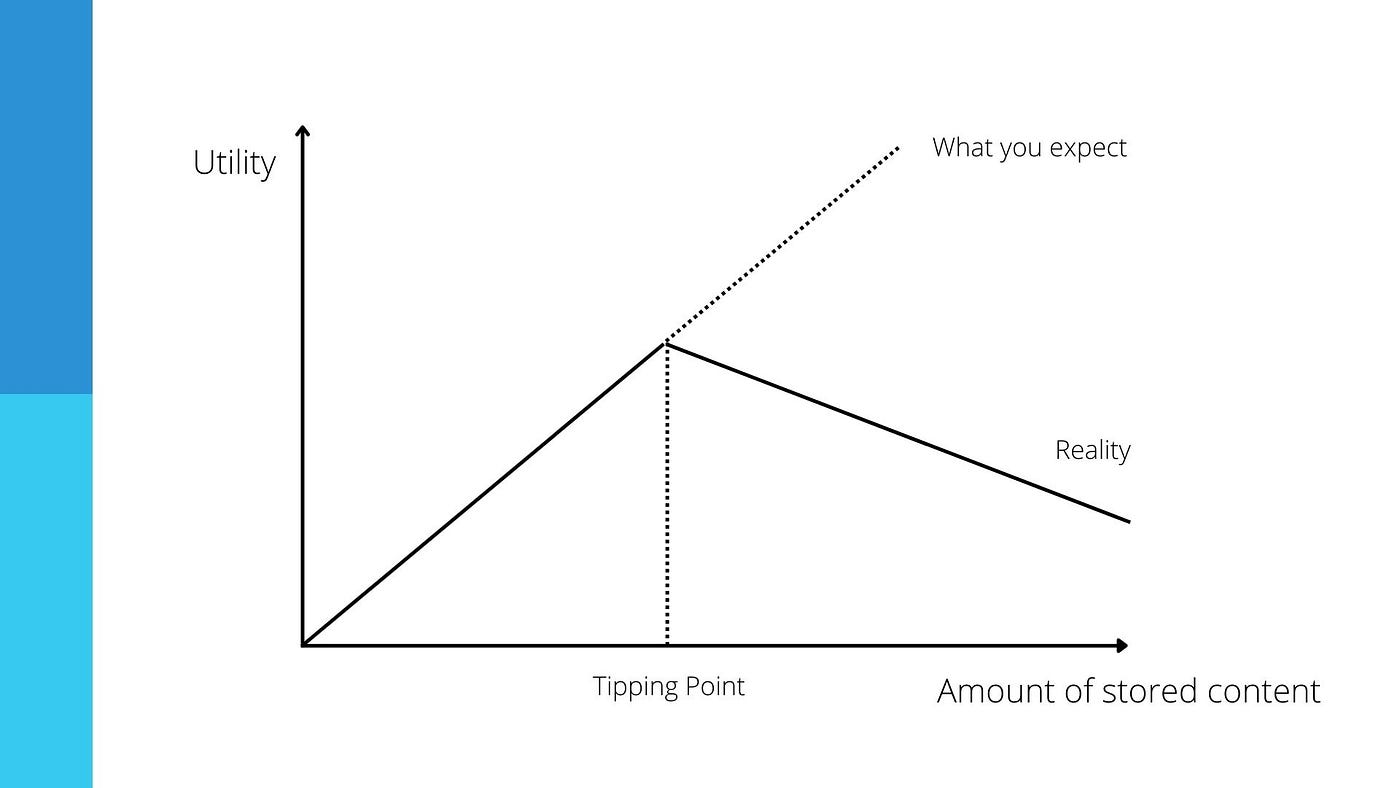
During our user interviews, we received a variety of feedback: “I have 4,000 pages in Evernote that I can’t manage anymore, but I don’t want to delete them,” “I have tens of thousands of links in Pocket that I don’t use anymore because I don’t know what’s important.” I believe that content and information are destined to be eventually replaced by other tools unless there is a mechanism to regularly declutter it (the latest tools have better search capabilities, the ability to enter metadata, refactoring of tags, etc., and the way management methods are evolving, so I’ll see what happens in this area).
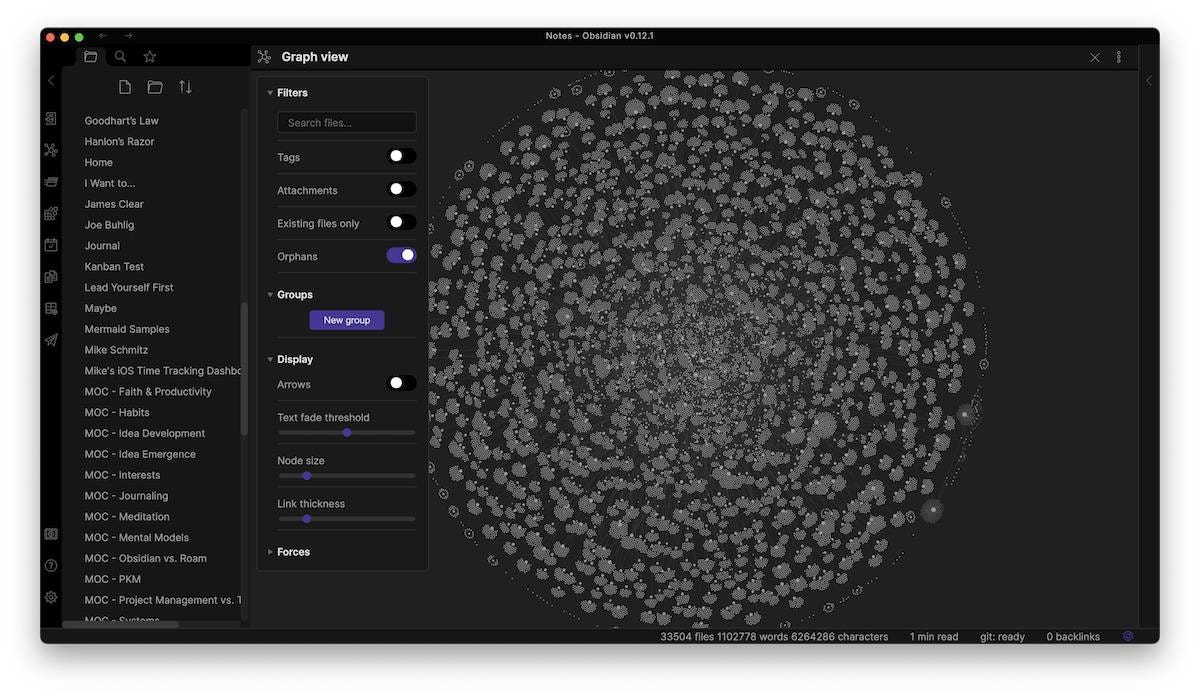
If it gets to this point, eventually all the nodes are linked to other nodes, and I can’t tell what is important anymore.
There is a striking sentence in Matthew Guay’s “Notes apps referenced above are where ideas go to die. And that’s good.”
Flipping through your old notes suddenly “feels like sifting through stale garbage,” as Dan Shipper found, disillusioned after building a galaxy of notes in Roam Research. It turns out most of our ideas and discoveries aren’t actually worth that much, not on their own anyhow.
To prevent this from happening, those who use or develop knowledge management tools need to recognize that ideas and their discovery are not worth much and consider mechanisms to reduce the amount of content and information that accumulates. Otherwise, the following will occur.
“So we try again. This next app will be the one true way. We had the philosophy all wrong before. Arrows, perhaps, are better than checklists. Folders and hierarchies versus wikis and backlinks. The sages saw technological enlightenment at the end of the revolution; we simply haven’t attained perfection yet.[…] Then we dump our newest thoughts into it, try the latest features to organize notes, until we’re back to safely forgetting things. Then the illusion gets shattered again, and we’re on to the next new thing.”
In this regard, I now think Readwise has the potential to do well; Readwise falls into the Temporary place in the three categories I mentioned above. I think some people come back to it to save tagging or check the Daily Highlight, but I think the core value of Readwise is its ability to be an aggregator of content and its ability to export that content.
Readwise supports integration with various services, so it would be able to take on the responsibility of storing contents and serve as a permanent place. But learning from the failure patterns of various knowledge management tools in the past, I think Readwise has not dared to create a function to manage the contents on Readwise.
Even when some knowledge management system saturates and users start using the next new service, Readwise will continue to be used if it can support and export the integration with the new service, because Readwise has already accumulated content! Readwise is a service that is already in use. Paradoxically, if too much content and information are stored in a knowledge management tool, it may not work in the end.
I hope this article can give you some insight into the use and development of your knowledge management tool. I’m still in the process of organizing my thoughts, so it is possible that my ideas will change, but I have come to the above conclusions based on my experience in creating knowledge management tools and seeing various failures.
I would like to write another article on tipping points, support for automatic export of content, conversion of information to knowledge, and methodology for organizing information. If you have any questions, please comment on this article or DM me on Twitter or Linkedin. And if you want to see my reading collection of knowledge management, please check out here.
